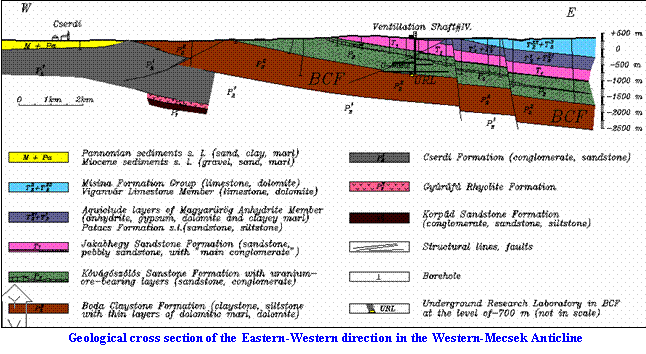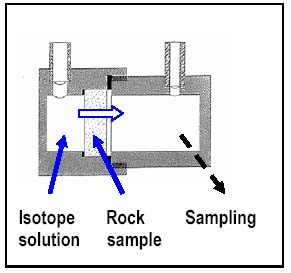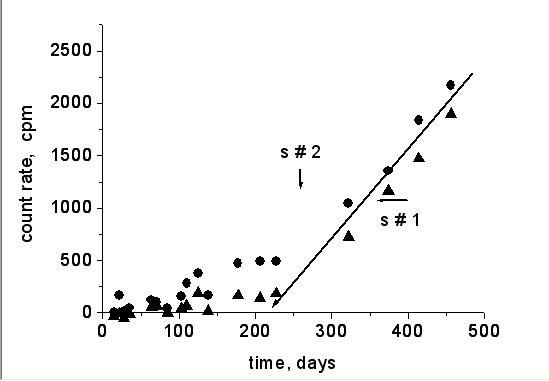Studies on migration of radioisotopes
Background
Studies on migration of radioisotopes in geological media are intended to furnish information on the perspectives for a possible repository site selection for high level nuclear waste in the future. By the present policy each country has to dispose her own nuclear waste in her own territory at the final stage, irrespectively whether the disposal concerns directly the spent fuel, or the reprocessed one, or even the waste left after transmutation.
Boda Claystone Formation
The Boda Claystone Formation was selected in a preliminary experts' evaluation as a possible candidate for waste site in Hungary. This formation is located in the Mecsek Mountains, SW of Hungary. The main mineral constituents are: albitic claystone, siltstone, dolomite, albitolite. (For further details, see Árkay et. al) . The formation is rather extended, the East - West cross section is shown here (from L. Kovács). The Boda Claystone is the bottom layer, marked in brown.

An underground research laboratory (URL) was established and had been in operation in 1994 - 1999 (see at the bottom of the ventillation shaft IV. on the figure). Several drills were driven from here, most of our samples is originated from these borecores.
Selection of radioisotopes
The radioisotopes used to study the migration processes were selected by considering two aspects. First, the studied isotopes are selected from the long hal life-time isotopes present in the high level waste. Thesecond criteria was the anionic form of occurence, since the clays sorb cations better, thus the non-sorbing anions may migrate farther. 129I, (t1/2= 107 y), H14CO3 (hydrocarbonate, with 14C, t1/2= 5700 y), and 99TcO4 (technetate, t1/2= 2x105 y) were selected, they are stable in their anionic form in the modestly reducing conditons and pH ca 8, characteristic for the undisturbed rocks and ground water.
Methods
The method used is the break-through measurement. There are two compartments in a cell separated by the studied sample (a slice cut from the borecore of the rock). One compartment is filled with ground water containing the isotope in anionic form, and the activity of the ground water is regularly measured in the other compartment. After a while ( > 100 days) the isotope diffuses through and its activity starts to increase.
 Scheme of the break-through measurement |  Typical break through curve obtained with 14-C spiked hydrocarbonate solution |
From the
slope of the increase the effective diffusion constant can be
calculated. An important advantage is that the method is
practically "gradientless" - the chemical concentration of the
radioisotope is neglectable (~10 -6 mol/l).
With these breakthrough measurements we participate in the EU FP-6 FUNMIG (Fundamental Processes of the Radionuclide Migration) Integrated Project.
Perliminary results
The effective diffusion constant of iodine was determined with varios methods in Boda Claystone samples. In average ~ 10-12 m2 s-1 walue was obtained. Considering the ~ 1.5 % porosity of the rock, this value is close to the self diffusion constant of ions in electrolytes. Thus, in first approximation, the migration of the iodine has taken place in the pores without any significant interaction with the rock. An approximate migration distance, 3 - 5 m can be estimated in a 105 year long period. The method, results etc. are decriben in detail in Ref. [Mell et. al]
Diffusion of the 14C spiked hydrocarbonate and 99TcO4 was also mesured recently on Boda Claystone samples. The obtained effective diffusion constants were in the same order of magnitude as found for iodine. The presence of "swelling" mineral (smectite) increased the apparent diffusivity. The pH has also an influence in the case of hydrocarbonate by shifting the HCO3 <=> CO3 equilibrium to the right. (In carbonate form an isotope exchange may take place between the solution and the solid rock carbonate (eg. dolomite). These preliminary results are also reported in a FUNMIG proceeedings. (Lázár et al.)
References
Árkay P., Balogh K., Demény A., Fórizs I., Nagy G., Máthé Z.,Composition, diagenetic and post-diagenetic alterations of a possibles radioactive waste repository site: the Boda Albitic Claystone Formation,
Acta Geologica Hungarica, 43 (2000) 351 - 378.
Kovács L. (Ed.),
Digest on the results of the short-term characterisation programme of the Boda Claystone Formation,
Mecsekérc - Puram, (1999) pp. 65
Lázár K., Megyeri J., Máthé Z.,
Influence of the mineral composition and the groundwater pH on the diffusion of 99-TcO4 and H^14CO3 anions through borecore samples of Boda Claystone
2nd Annual Workshop Proceedings 6th EC FP- FUNMIG IP , Stockholm 2006. (in press) (pdf download)
Mell P., Megyeri J., Riess L., Máthé Z., Hámos G., Lázár K.,
Diffusion of Sr, Cs, Co and I in argillaceous rock as studied by radiotracers,
Journal of Radioanaytical and Nuclear Chemistry, 268 (2006) 411 - 417.

